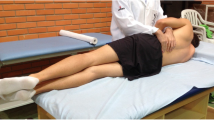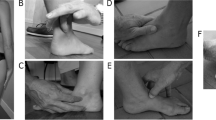Abstract
Repeated measures design. This study examined recovery of postural equilibrium (centre of pressure (COP) excursion, time to recover balance, and the number of postural adjustments) following unexpected support surface perturbation in healthy participants with and without a rigid lumbar corset to reduce lumbar motion. Lumbar spine movement is thought to aid postural stability, especially when a “hip” (lumbopelvic) strategy is required, such as in response to large and fast perturbations. Delayed onset of lumbar spine movement in association with prolonged postural recovery in chronic low back pain implies reduced spinal motion could underpin balance deficits in this group. However, other explanations such as poor proprioception cannot be excluded, and the relationship between lumbar movement and postural stability remains unclear. We hypothesized restricted lumbar spine movement would impair control of postural recovery following support surface perturbation. Participants regained postural stability following unexpected support surface perturbations in different directions (forward and backward), with different amplitudes (small, medium, and large), with and without restriction of spine motion by a hard lumbar corset. Although the latency of the postural adjustment was unaffected by the corset, the quality of postural recovery was compromised (increased COP range, time taken for postural recovery, and number of postural adjustments) during recovery, especially in response to large perturbation. Restriction of lumbar spine movement adversely affects postural recovery. The results suggest movement of the lumbar spine, although small in amplitude, is critical for efficient recovery of standing balance.



Similar content being viewed by others
References
Baecke JA, Burema J, Frijters JE (1982) A short questionnaire for the measurement of habitual physical activity in epidemiological studies. Am J Clin Nutr 36:936–942
Brauer SG, Woollacott M, Shumway-Cook A (2001) The interacting effects of cognitive demand and recovery of postural stability in balance-impaired elderly persons. J Gerontol A Biol Sci Med Sci 56:M489–M496
Cholewicki J, Reeves NP, Everding VQ, Morrisette DC (2007) Lumbosacral orthoses reduce trunk muscle activity in a postural control task. J Biomech 40:1731–1736
Grimstone SK, Hodges PW (2003) Impaired postural compensation for respiration in people with recurrent low back pain. Exp Brain Res 151:218–224
Gruneberg C, Bloem BR, Honegger F, Allum JH (2004) The influence of artificially increased hip and trunk stiffness on balance control in man. Exp Brain Res 157:472–485
Gurfinkel VS, Kots YM, Paltsev EI, Feldman AG (eds) (1971) The compensation of respiratory disturbances of erect posture of man as an example of the organisation of interarticular interaction. MIT Press, Cambridge
Henry SM, Fung J, Horak FB (1998) EMG responses to maintain stance during multidirectional surface translations. J Neurophysiol 80:1939–1950
Hodges P, Cresswell A, Thorstensson A (1999) Preparatory trunk motion accompanies rapid upper limb movement. Exp Brain Res 124:69–79
Hodges PW, Gurfinkel VS, Brumagne S, Smith TC, Cordo PC (2002) Coexistence of stability and mobility in postural control: evidence from postural compensation for respiration. Exp Brain Res 144:293–302
Hodges PW, Coppieters MW, Macdonald D, Cholewicki J (2013) New insight into motor adaptation to pain revealed by a combination of modelling and empirical approaches. Eur J Pain 138:1138–1146
Horak FB, Nashner LM (1986) Central programming of postural movements: adaptation to altered support-surface configurations. J Neurophysiol 55:1369–1381
Hosoda M, Masuda T, Isozaki K, Takayanagi K, Sakata K, Takakuda K, Nitta O, Morita S (2007) Effect of occlusion status on the time required for initiation of recovery in response to external disturbances in the standing position. Clin Biomech (Bristol, Avon) 22:369–373
Jones SL, Hitt JR, Desarno MJ, Henry SM (2012) Individuals with non-specific low back pain in an active episode demonstrate temporally altered torque responses and direction-specific enhanced muscle activity following unexpected balance perturbations. Exp Brain Res 221:413–426
Kantor E, Poupard L, Le Bozec S, Bouisset S (2001) Does body stability depend on postural chain mobility or stability area? Neurosci Lett 308:128–132
Mackey DC, Robinovitch SN (2005) Postural steadiness during quiet stance does not associate with ability to recover balance in older women. Clin Biomech (Bristol, Avon) 20:776–783
Mok NW, Brauer SG, Hodges PW (2007) Failure to use movement in postural strategies leads to increased spinal displacement in low back pain. Spine 32:E537–E543
Mok NW, Brauer SG, Hodges PW (2011a) Changes in lumbar movement in people with low back pain are related to compromised balance. Spine 36:E45–E52
Mok NW, Brauer SG, Hodges PW (2011b) Postural recovery following voluntary arm movement is impaired in people with chronic low back pain. Gait Posture 34:97–102
Munoz F, Salmochi JF, Faouen P, Rougier P (2010) Low back pain sufferers: is standing postural balance facilitated by a lordotic lumbar brace? Orthop Traumatol Surg Res 96:362–366
Puckree T, Lauten VA, Moodley S, Naidoo J, Ramsammy K (2005) Thoracolumbar corsets alter breathing pattern in normal individuals. Int J Rehabil Res 28:81–85
Radebold A, Cholewicki J, Polzhofer GK, Greene HS (2001) Impaired postural control of the lumbar spine is associated with delayed muscle response times in patients with chronic idiopathic low back pain. Spine 26:724–730
Reeves NP, Everding VQ, Cholewicki J, Morrisette DC (2006) The effects of trunk stiffness on postural control during unstable seated balance. Exp Brain Res 174:694–700
Rougier P, Garin M (2006) Performing saccadic eye movements modifies postural control organisation. Neurophysiol Clin 36:235–243
Sheeran L, Sparkes V, Caterson B, Busse-Morris M, van Deursen R (2012) Spinal position sense and trunk muscle activity during sitting and standing in nonspecific chronic low back pain: classification analysis. Spine 37:E486–E495
Shumway-Cook A, Woollacott MH (2007) Motor control: translating research into clinical practice. Lippincott Williams & Wilkins, Philadelphia
Smith M, Coppieters MW, Hodges PW (2005) Effect of experimentally induced low back pain on postural sway with breathing. Exp Brain Res 166:109–117
van Dieen JH, Koppes LL, Twisk JW (2010) Low back pain history and postural sway in unstable sitting. Spine 35:812–817
WHO Expert Consultation (2004) Appropriate body-mass index for Asian populations and its implications for policy and intervention strategies. Lancet 363:157–163
Willigenburg NW, Kingma I, van Dieen JH (2012) Precision control of an upright trunk posture in low back pain patients. Clin Biomech (Bristol, Avon) 27:866–871
Willigenburg NW, Kingma I, van Dieen JH (2013) Center of pressure trajectories, trunk kinematics and trunk muscle activation during unstable sitting in low back pain patients. Gait Posture. doi:10.1016/j.gaitpost.2013.02.010
Woollacott MH, Shumway-Cook A, Nashner LM (1986) Aging and posture control: changes in sensory organization and muscular coordination. Int J Aging Hum Dev 23:97–114
Acknowledgments
We thank Peggy Chan, Nelson Cheng, Shirley Le, and Kopey Yuen for assistance with data collection. NM was supported by the Competitive Research Grant for Junior Researchers, The Hong Kong Polytechnic University. PH was support by the National Health and Medical Research Council of Australia (APP1002190).
Author information
Authors and Affiliations
Corresponding author
Rights and permissions
About this article
Cite this article
Mok, N.W., Hodges, P.W. Movement of the lumbar spine is critical for maintenance of postural recovery following support surface perturbation. Exp Brain Res 231, 305–313 (2013). https://doi.org/10.1007/s00221-013-3692-0
Received:
Accepted:
Published:
Issue Date:
DOI: https://doi.org/10.1007/s00221-013-3692-0




